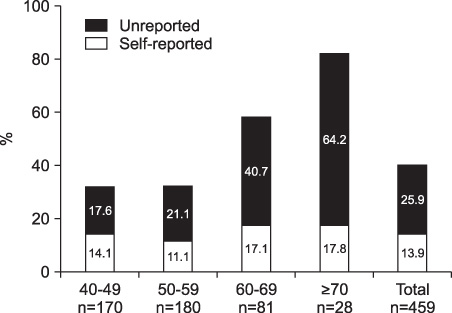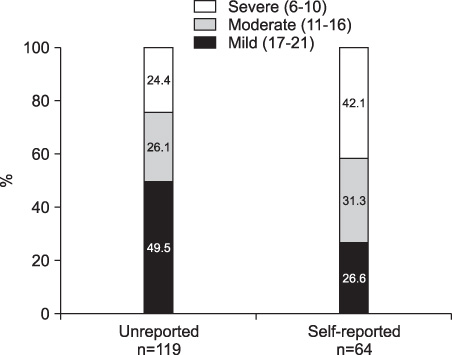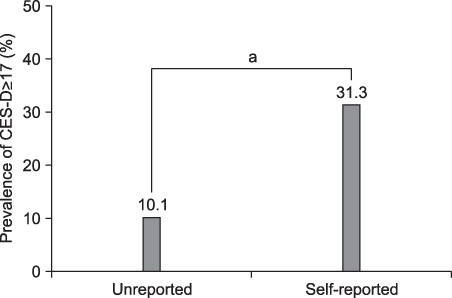Korean J Urol.
2009 Sep;50(9):902-907.
Is Self-Report of Erectile Dysfunction Associated with Severity, Cardiovascular Disease Risk Factors, and Depression?
- Affiliations
-
- 1Department of Urology, Pusan National University School of Medicine, Busan, Korea. joon501@naver.com
Abstract
- PURPOSE
The aim of this study was to evaluate whether cardiovascular disease risk factors and depression are associated with the frequency of self-report in patients with erectile dysfunction (ED). MATERIALS AND METHODS: Randomly selected men more then 40 years of age who visited the department of urology between January 2005 and July 2008 were evaluated by clinical examination and questionnaires. Trained doctors assessed the participants by using structured questionnaires that included medical history as well as report of ED. All participants were evaluated for cardiovascular disease risk factors. The group with unreported ED was defined as men with an International Index of Erectile Function-5 (IIEF-5) score of < or =21 who did not self-report ED. The group with self-reported ED was defined as men as above who self-reported ED. Symptoms of depression were assessed by the Center for Epidemiological Studies-Depression Scale (CES-D). RESULTS: The mean age of a total of 459 enrolled patients was 53.4+/-7.8 years. The overall frequency of ED was 39.8%. Of the total study group, 25.9% were categorized in the unreported ED group and 13.9% in the self-reported ED group. The men with self-reported ED had significantly severe forms of ED and a higher frequency of cardiovascular disease risk factors than did the men with unreported ED. Moreover, the self-reported ED group had a significantly higher frequency of symptoms of depression. CONCLUSIONS: Our results suggest that men with self-reported ED had a higher frequency of cardiovascular disease risk factors and symptoms associated with depression than did men with unreported ED. Furthermore, men with self-reported ED had more severe ED than did men with unreported ED.
Keyword
Figure
Reference
-
1. Moreira ED Jr, Kim SC, Glasser D, Gingell C. Sexual activity, prevalence of sexual problems, and associated help-seeking patterns in men and women aged 40-80 years in Korea: data from the Global Study of Sexual Attitudes and Behaviors (GSSAB). J Sex Med. 2006. 3:201–211.2. Kloner RA. Erectile dysfunction as a predictor of cardiovascular disease. Int J Impot Res. 2008. 20:460–465.3. Greenstein A, Chen J, Miller H, Matzkin H, Villa Y, Braf Z. Does severity of ischemic coronary disease correlate with erectile function? Int J Impot Res. 1997. 9:123–126.4. Feldman HA, Goldstein I, Hatzichristou DG, Krane RJ, McKinlay JB. Impotence and its medical and psychosocial correlates: results of the Massachusetts Male Aging Study. J Urol. 1994. 151:54–61.5. Feldman HA, Johannes CB, Derby CA, Kleinman KP, Mohr BA, Araujo AB, et al. Erectile dysfunction and coronary risk factors: prospective results from the Massachusetts male aging study. Prev Med. 2000. 30:328–338.6. Ledda A. Cigarette smoking, hypertension and erectile dysfunction. Curr Med Res Opin. 2000. 16:Suppl 1. S13–S16.7. Braun M, Wassmer G, Klotz T, Reifenrath B, Mathers M, Engelmann U. Epidemiology of erectile dysfunction: results of the 'Cologne Male Survey'. Int J Impot Res. 2000. 12:305–311.8. Ahn TY, Lee DS, Kang W, Hong JH, Kim YS. Validation of an abridged Korean version of the International Index of Erectile Function (IIEF-5) as a diagnostic tool for erectile dysfunction. Korean J Urol. 2001. 42:535–540.9. American Diabetes Association. Diagnosis and classification of diabetes mellitus. Diabetes Care. 2004. 27:Suppl 1. S5–S10.10. Expert Panel on Detection, Evaluation, and Treatment of High Blood Cholesterol in Adults. Executive summary of the third report of the national cholesterol education program (NCEP) expert panel on detection, evaluation, and treatment of high blood cholesterol in adults (adult treatment panel III). JAMA. 2001. 285:2486–2497.11. Cho MJ, Kim KH. Diagnostic validity of the CES-D (Korean version) in the assessment of the DSM-III-R major depression. J Korean Neuropsychiatr Assoc. 1993. 32:381–399.12. Ahn TY, Park JK, Lee SW, Hong JH, Park NC, Kim JJ, et al. Prevalence and risk factors for erectile dysfunction in Korean men: results of an epidemiological study. J Sex Med. 2007. 4:1269–1276.13. Analysis of Sexual Behaviour in France (ACSF). A comparison between two modes of investigation: telephone survey and face-to-face survey. ASCF principal investigators and their associates. AIDS. 1992. 6:315–323.14. Kim JA, Montagnani M, Koh KK, Quon MJ. Reciprocal relationships between insulin resistance and endothelial dysfunction: molecular and pathophysiological mechanisms. Circulation. 2006. 113:1888–1904.15. Kawanishi Y, Lee KS, Kimura K, Koizumi T, Nakatsuji H, Kojima K, et al. Screening of ischemic heart disease with cavernous artery blood flow in erectile dysfunctional patients. Int J Impot Res. 2001. 13:100–103.16. Roumeguère T, Wespes E, Carpentier Y, Hoffmann P, Schulman CC. Erectile dysfunction is associated with a high prevalence of hyperlipidemia and coronary heart disease risk. Eur Urol. 2003. 44:355–359.17. Chung WS, Sohn JH, Park YY. Is obesity an underlying factor in erectile dysfunction? Eur Urol. 1999. 36:68–70.18. Bacon CG, Mittleman MA, Kawachi I, Giovannucci E, Glasser DB, Rimm EB. Sexual function in men older than 50 years of age: results from the health professionals follow-up study. Ann Intern Med. 2003. 139:161–168.19. Dicpinigaitis PV, Tso R, Banauch G. Prevalence of depressive symptoms among patients with chronic cough. Chest. 2006. 130:1839–1843.20. De Berardis G, Pellegrini F, Franciosi M, Belfiglio M, Di Nardo B, Greenfield S, et al. Clinical and psychological predictors of incidence of self-reported erectile dysfunction in patients with type 2 diabetes. J Urol. 2007. 177:252–257.
- Full Text Links
- Actions
-
Cited
- CITED
-
- Close
- Share
- Similar articles
-
- Modifying Risk Factors in the Management of Erectile Dysfunction: A Review
- Effects of Oral Sildenafil on Erectile Function according to the Number of Accompanied Cardiovascular Risk Factors
- Obesity and Erectile Dysfunction
- The Correlation between Erectile Dysfunction and the Severity of Coronary Artery Involvement in Patients with Coronary Artery Disease
- Metabolic Syndrome and Erectile Dysfunction





